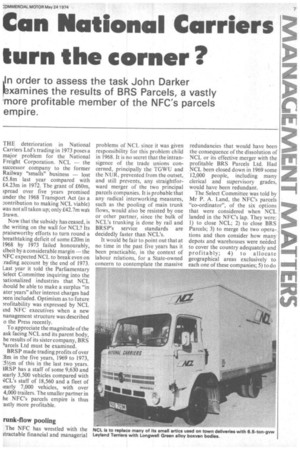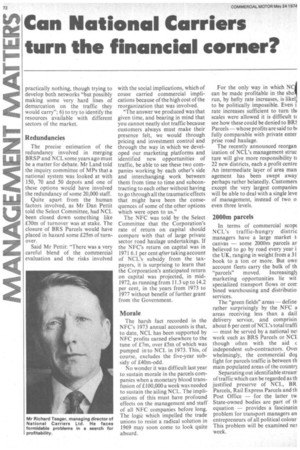Can National Carriers turn the corner ?
Page 73

Page 74

If you've noticed an error in this article please click here to report it so we can fix it.
(ri order to assess the task John Darker xamines the results of BRS Parcels, a vastly more profitable member of the NFC's parcels empire.
THE deterioration in National Carriers Ltd's trading in 1973 poses a major problem for the National Freight Corporation, NCL — the successor company to the former Railway "smalls" business — lost £5.8m last year compared with £4.23m in 1972. The grant of £60m, spread over five years promised under the 1968 Transport Act (as a ontribution to making NCL viable) was not all taken up; only £42.7m was Jrawn.
Now that the subsidy has ceased, is the writing on the wall for NCL? Its praiseworthy efforts to turn round a breathtaking deficit of some £20m in 1968 by 1973 failed honourably, albeit by a considerable margin — the \1FC expected NCL to break even on .rading account by the end of 1973. Last year it told the Parliamentary Select Committee inquiring into the iationalized industries that NCL ihould be able to make a surplus "in ater years" after interest charges had )een included. Optimism as to future nofitability was expressed by NCL ind NFC executives when a new nanagement structure was described o the Press recently.
To appreciate the magnitude of the ask facing NCL and its parent body, he results of its sister company, BRS 'arcels Ltd must be examined.
BRSP made trading profits of over :8m in the five years, 1969 to 1973, :51/2m of this in the last two years. 3RSP has a staff of some 9,630 and 'early 3,500 vehicles compared with ■ ICL's staff of 18,560 and a fleet of 'early 7,000 vehicles, with over 4,000 trailers. The smaller partner in he NFC's parcels empire is thus 'astly more profitable. problems of NCL since it was given responsibility for this problem child in 1968. It is no secret that the intransigence of the trade unions concerned, principally the TGWU and the NUR, prevented from the outset, and still prevents, any straightforward merger of the two principal parcels companies. It is probable that any radical interworking measures, such as the pooling of main trunk flows, wauld also be resisted by one or other partner, since the bulk of NCL's trunking is done by rail and BRSP's service standards are decidedly faster than NCL's.
It would be fair to point out that at no time in the past five years has it been practicable, in the context of labour relations, for a State-owned concern to contemplate the massive redundancies that would have been the consequence of the dissolution of NCL or its effective merger with the profitable BRS Parcels Ltd. Had NCL been closed down in 1969 some 12,000 people, including many clerical and supervisory grades, would have been redundant.
The Select Committee was told by Mr P. A. Land, the NFC's parcels "co-ordinator", of the six options that were considered when NCL landed in the NFC's lap. They were: 1) to close NCL; 2) to close BRS Parcels; 3) to merge the two operations and then consider how many depots and warehouses were needed to cover the country adequately and profitably; 4) to allocate geographical areas exclusively to each one of these companies; 5) to do practically nothing, though trying to develop both networks "but possibly making some very hard lines of demarcation on the traffic they would carry"; 6) to try to identify the resources available with different sectors of the market.
Redundancies
The precise estimation of the redundancy involved in merging BR SP and NCL some years ago must be a matter for debate. Mr Land told the inquiry committee of MPs that a national system was looked at with 150, 70 and 50 depots and one of these options would have involved the redundancy of some 20,000 staff.
Quite apart from the human factors involved, as Mr Dan Pettit told the Select Committee, had NCL been closed down something like £30m of turnover was at stake. The closure of BRS Parcels would have placed in hazard some £25m of turnover.
Said Mr Pettit: "There was a very careful blend of the commercial evaluation and the risks involved with the social implications, which of co use carried commercial implications because of the high cost of the reorganization that was involved.
"The answer we produced was that given time, and bearing in mind that you cannot neatly slot traffic because customers always must make their presence felt, we would through pricing and investment control and through the way in which we developed our marketing platforms and identified new opportunities of traffic, be able to see these two companies working by each other's side and interchanging work between them from time to time and subcontracting to each other without having to go through all the traumatic effects that might have been the consequences of some of the other options which were open to us."
The NFC was told by the Select Committee that the Corporation's rate of return on capital should compare with that of large private sector road haulage undertakings. If the NFC's return on capital was in 1971 6.1 per cent after taking account of NCL's subsidy from the taxpayers, it is surprising to learn that the Corporation's anticipated return on capital was projected, in mid1972, as running from 11.3 up to 14.2 per cent, in the years from 1973 to 1977 without benefit of further grant from the Government.
Morale
The harsh fact recorded in the NFC's 1973 annual accounts is that, to date, NCL has been supported by NFC profits earned elsewhere to the tune of £7m, over £5m of which was pumped in to NCL in 1973. This, of course, excludes the five-year subsidy of £40m-odd.
No wonder it was difficult last year to sustain morale in the parcels companies when a monetary blood transfusion of £100,000 a week was needed to sustain the ailing NCL. The implications of this must have profound effects on the management and staff of all NFC companies before long. The logic which impelled the trade unions to resist a radical solution in 1969 may soon come to look quite absurd. For the only way in which NC can be made profitable in the sho run, by hefty rate increases, is likel4 to be politically impossible. Even rate increases sufficient to turn th( scales were allowed it is difficult tt see how these could be denied to WO. Parcels — whose profits are said to 134 fully comparable with private enter prise road haulage.
The recently announced reorgan ization of NCL's management struc ture will give more responsibility tt 22 new districts, each a profit centre An intermediate layer of area man agement has been swept away perhaps rather belatedly. Customers except the very largest companies will be able to deal with a single leve of management, instead of two o even three levels.
2000m parcels
In terms of commercial scope NCL's traffic-hungry distric managers have a large market t. canvas — some 2000m parcels ar believed to go by road every year i the UK, ranging in weight from a 3 book to a ton or more, But own account fleets carry the bulk of th "parcels" moved. Increasing!) marketing opportunities lie wit specialized transport flows or corr bined warehousing and distributio services.
The "green fields" areas — define rather surprisingly by the NFC a areas receiving less than a dail delivery service, and comprisin about 6 per cent of NCL's total traffi — must be served by a national nei work such as BRS Parcels or NCI though often with the aid c independent sub-contractors. °ye, whelmingly, the commercial doi fight for parcels traffic is between th main populated areas of the countr3 Separating out identifiable streanof traffic which can be regarded as th justified preserve of NCL, BR Parcels, Rail Express Parcels and th Post Office — for the latter tw State-owned bodies are part of th equation — provides a fascinatin problem for transport managers an entrepreneurs of all political colour This problem will be examined ne) week.




































































































































